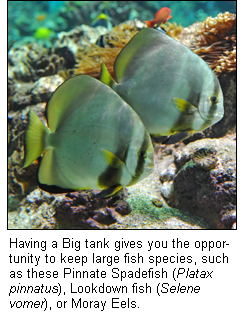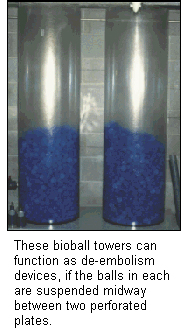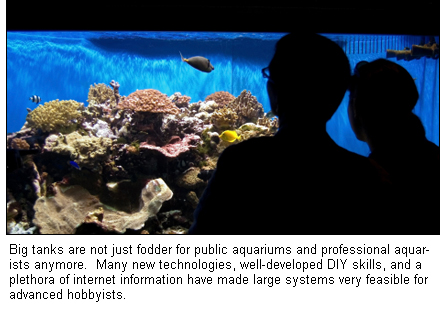Stepping Large: The Big Tank, part 1
In The Beginning

At some point in the life of your marine aquarium, you are likely to look at it and think, I have done all I can with this tank. Though you have spent long hours fawning over it, dreaming of the day when it will be complete, you secretly hope it will never be totally done. You see, the beauty of the experience is in the journey. When the day finally comes that all the space is filled, no more fish will fit, and all you do is prune the same corals over and over again, you are immediately compelled to start another tank. When you think back on it, you might even recall ourselves thinking about our next tank as early as the beginning of the one you just finished. I think every aquarist has an element of dreamer in them. So when the time comes to realize the dream of a new tank, there is one question that really must be settled first: How big is it going to be?
Some time ago, I published an article entitled, Nanoreef Aquariums Add Diversity to an Aquarists Repertoire. In that piece, I presumed the challenge of starting a nanoreef aquarium would occupy the intrepid aquarist for a little while, at least. Since then, I have realized that there must be some of you who would like to go the other way. In this article then, we will explore what it takes to go big, really big. When I say big, I mean 250 gallons or more. There is so much to consider when going big that many people will immediately be turned off by the idea, but the improved water stability a large tank offers provides a great opportunity to keep many of the most sensitive marine organisms. For the purposes of this article, let us assume, then, that you have decided to go through with it. You are going to put in a huge saltwater aquarium. You have also decided that, though it might be advisable, you are going to do most or all of the work yourself. You must remember, this endeavor will require full commitment. Once you decide to go down this road it will be very hard to back out, so success is really the only option. What, then, are the choices available to you?

Make it Sturdy, Make it Safe
It is natural to try and go as big as possible, but for the sake of argument, let us assume that you decide to try your hand on a 250 gallon tank. A tank this large will weigh a ton, literally. Actually, it is sure to weigh far more than a ton. 250 gallons of saltwater weighs about 2,171 lbs. Some of that water will be displaced by even heavier volumes of sand and rock. Add to this the weight of the tank, a stand, cabinetry, life support systems, and lighting equipment, and your floorboards might not stand up to the strain. Most floors are not engineered to handle that kind of load, and there is a very good chance you will have to add additional support. If the tank is on the ground floor, consider adding a concrete pad or pier blocks underneath the sub-floor directly below the tank. If the tank is to be above a basement or on the second floor, multiple sturdy pillars should be erected to distribute the load to the ground floor (minimum 4 x 4). It is a good idea to assume the tank will weigh 2 to 3 times more than your calculations indicate, and construct your supports accordingly. In all honesty, it is a highly advisable to have this type of work done by a professional contractor. The price is easily offset by the comfort of knowing that a skilled craftsmen, who is licensed and bonded, has built you a sturdy and long-lasting platform for your dear aquarium.
The next most crucial element of a big tank is the electrical demand. A big tank is going to run heavy-duty pumps 24 hours per day, and intense lights for almost half that long. You will need to bring in a professional electrician to wire new circuits into the breaker box of your home, and extend several GFCI protected outlets to the tank area. It is best to use at least two circuits, one dedicated to the lights and one for the life support system. That way, if something overloads the circuit with the lights and trips the breaker (which is easy to do when running metal halides), the life support system will stay running. Make sure your electrician understands that the work is for a large aquarium, and performs the job accordingly.
Next you must choose your tank. Glass and acrylic are obviously the options, but which is better? The answer, hands down, is acrylic. Not only is it clearer and stronger, it is lighter. The tank is the only place in the project where you can significantly reduce the weight of the system. Moreover, any tank this large will likely need to be custom-made for you since most factory made tanks come in a maximum size of about 180 gallons. It will be easier to build a more creative looking tank for your space if it is constructed of acrylic. New acrylic tanks are strong, long-lasting, and resist the yellowing that plagues users of older such aquaria. Consider also the height of the tank, and the size of the largest horizontal face. The pressure to which the walls and bottom will be subjected is a function of the height of the water column, and the longest horizontal spans will flex the most. An aquarium that is 4 feet high will require walls that are at least 11/8 to 1 inches thick. At that size, glass is prohibitively heavy and unwieldy. Also, scratches in acrylic can be buffed out even if the tank is living, while those in glass create permanent scars.

Make it Livable
The next problem to tackle is that of life support. The first decision must be whether to create the filtration system under the tank, adjacent to it, or remotely. Each option is possible, and the decision really comes down to how much room is available to dedicate to the tank. The space below a tank is naturally limited, and the components of the life-support system must fit. Therefore it will need to be small, efficient, and sparse. If, instead, there is an alternate location that can house the filtration, consider placing it there. Good candidates include a large closet, the area below a stairwell, or a basement. You should be sure to choose an area that can be ventilated easily to avoid damage caused by humid air. Also, you must consider the distance and height the water will have to travel to get to and from the filter. Not only will a powerful pump be required for remote applications, so too might insulation around the PVC plumbing you install.
To achieve excellent water quality, efficient filtration equipment is a must. In general, I am an advocate of natural style tanks, but at this scale there are more efficient means of achieving excellent water quality. Of course, ample amounts of live rock and a medium-fine sand bed in the main display will be hugely beneficial. However, for a 250 gallon tank you would need a 75 to 100 gallon sump tank with a deep sand bed and/or refugium, the footprint of which is fairly sizable. Instead, de-embolism towers, fluidized sand beds, coil denitrators, and of course protein skimmers, can replace the processes the go on in a deep sand bed, while fitting in a much smaller space. Best of all, as few as two pumps might be needed to get the water back into the main tank. Here is a hypothetical set-up:
The overflow weir distributes water to the de-embolism tower, which flows into a medium size reservoir. An oversized protein skimmer sits in the reservoir and removes skimmate, while a nearby coil denitrator performs denitrification in liu of a deep sand bed. From the reservoir, an external pump pushes water through a fluidized bed, and possibly all the way back to the main display (depending on the design of the reaction chamber and the distance back to the tank). Inside the main tank, turnover is augmented by powerheads, a closed-loop circulation, and/or the return pump.
De-Embolism TowerThe piece of equipment is actually really simple, but highly efficient. Essentially, it is nothing more than a tall tube full of bio balls. The water enters at the top, pre-filtered at the overflow bulkhead, and is distributed evenly over the 1 ft wide cross-section of the tower by a plastic plate perforated by many smallish holes. The water trickles down the surfaces of 3 to 4 feet of bio balls, finally falling into the reservoir through another perforated plate. The effect of the tower is two-fold. First, it provides lots of extra surface area for bacterial growth, along with appropriately oxygenated water for nitrification. Second, the surface area also increases gas exhange rates; carbon dioxide and oxygen are more easily equilibrated to optimal levels within the tower.

Next Time:
Keep your eyes peeled for the conclusion of this article. In Part 2, this piece concludes with brief descriptions of the remainder of this hypothetical set up. It also touches briefly on some of the more superfluous equipment options available to supercharge your large tank set up. After that, all you need to do is provide some lights, and you are one your way to having that Big tank!
Works Cited:
Hanley, C.J. Nanoreef Aquariums Add Diversity to an Aquarists Repertoire. Quality Marine Online. 2010. URL: < http://www.qualitymarine.com/News/Feature-Article... >
Persson, C. The Large Home Aquarium. Wet Pet Gazette. Aquaarticles Online. 2003. URL: < http://www.aquarticles.com/articles/management/Pe... >